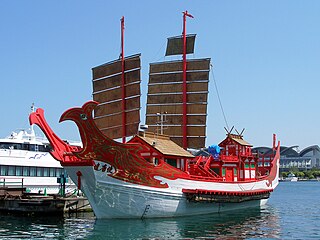
Shanghai is a direct-administered municipality and the most populous urban area in China. The city is located on the Chinese shoreline on the southern estuary of the Yangtze River, with the Huangpu River flowing through it.

Pudong is a district of Shanghai located east of the Huangpu, the river which flows through central Shanghai. The name Pudong was originally applied to the Huangpu's east bank, directly across from the west bank or Puxi, the historic city center. It now refers to the broader Pudong New Area, a state-level new area which extends all the way to the East China Sea.

Shanghai American School (SAS) is an independent international school located in Shanghai, China. Founded in 1912, SAS has two campuses and over 2,800 students enrolled in Pre-K through 12th grade.

Taihō (大宝) was a Japanese era name after a late 7th century interruption in the sequence of nengō after Shuchō and before Keiun. This period spanned the years from March 701 through May 704. The reigning emperor was Monmu-tennō (文武天皇).

Dulwich College Shanghai Pudong (上海德威外籍人员子女学校) is a private secondary school and a school for children of foreign personnels, located in Pudong, Shanghai, China. The campus was opened in 2003, and is owned and operated by Education in Motion, a British company.

Etonkids International Educational Group is an early education and K-12 services provider in the People's Republic of China.

The Japanese missions to Tang China were Japanese efforts to learn Chinese culture and civilization from Tang China, in the 7th, 8th and 9th centuries. The nature of those contacts evolved gradually from political and ceremonial change into cultural exchanges, and the process accompanied growing commercial ties which developed over time.
Japanese missions to Ming China represent a lens for examining and evaluating the relationships between China and Japan in the 15th through the 17th centuries. The nature of these bilateral contacts encompassed political and ceremonial acknowledgment as well as cultural exchanges. The evolution of diplomatic ties accompanied the growing commercial ties which grew over time.
Kenchū Keimitsu (堅中圭密) was a Japanese Zen Buddhist monk and diplomat in the Muromachi period. He was the chief envoy of a mission sent by the Ashikaga shogunate to the court of the Yongle Emperor in Nanjing. He would return to China at the head of four subsequent missions to the Chinese Imperial court in Beijing.

Sakugen Shūryō was a Japanese Zen Buddhist monk, a poet and diplomat in the Muromachi period. He was the chief envoy of a 1547 mission sent by the Ashikaga shogunate to the court of the Jiajing Emperor in Beijing.
Ryōan Keigo was a Japanese Zen Buddhist monk and diplomat in the Muromachi period. He was the chief envoy of a 1511–1513 mission sent by the Ashikaga shogunate to the court of the Zhengde Emperor in Beijing.
Japanese missions to Sui China represent a lens for examining and evaluating the relationship between the Sui dynasty and Japan in the 7th century. The nature of these bilateral contacts evolved gradually from political and ceremonial acknowledgment to cultural exchanges; and the process accompanied the growing commercial ties which developed over time.

Joshua A. Fogel is an American-Canadian Sinologist, historian, and translator who specializes in the history of modern China, especially focusing on the cultural and political relations between China and Japan. Before retiring and becoming professor emeritus in 2024, he held a Tier 1 Canada Research Chair at York University in Toronto from 2005. Before that he taught at Harvard University (1981–1988) and the University of California, Santa Barbara (1989–2005). He is a fellow of the Royal Society of Canada.

The Korean International School in Beijing is an international school in Wangjing, Chaoyang District, Beijing. It serves grades 1–12. It has instruction in Korean, Chinese, and English.

The Shanghai Japanese School (SJS) is a Japanese international school serving primary and junior high school levels in Shanghai. It has two campuses, one in Hongqiao and one in Pudong. The school's teachers are Japanese citizens. The school also has a senior high school component.
The Edwin O. Reischauer Lectures is a series of lectures at Harvard University sponsored by the John King Fairbank Center established in 1986 to be given annually in memory of Edwin O. Reischauer. The lectures in Asian Studies are then published by Harvard University Press.

The Shanghai Ferry is a system of ferry routes across the Huangpu River in Shanghai. The ferry service started on January 5, 1911 by the municipal authorities in Pudong. Before the 1970s, the ferry service was the only way to cross the Huangpu River. In the 1980s, the Shanghai Ferry became one of the busiest ferry services in the world. In the 1990s, as bridges and tunnels across the Huangpu river were built, the ferry service saw a sharp drop in ridership. The Shanghai Ferry currently consists of 18 ferry lines and is operated by the state-owned Shanghai Ferry Company.
RYB Education is a publicly listed company for preschool education in the People's Republic of China. As measured by annual total revenues in 2016, the company is the largest provider of early childhood education service in China. It owns three preschool-educational brands, namely RYB Parent-Child Garden, RYB Kindergarten, and Zhudou Parenting App-kit Club, and has strategic cooperation with some American preschool education institutes. The firm is listed on the New York Stock Exchange. The company was registered in the Cayman Islands, and its headquarter is in Beijing.
Education in Shanghai includes five years of primary education, four years of junior secondary education, and three years of senior secondary education, as well as higher education, including universities and colleges.
A school for children of foreign personnel (外籍人员子女学校) is a type of non-public K–12 school in mainland China. This type of school can only admit the children of people with foreign nationality and legal Chinese long-term residence visas, and their children are also required to have foreign nationality.













